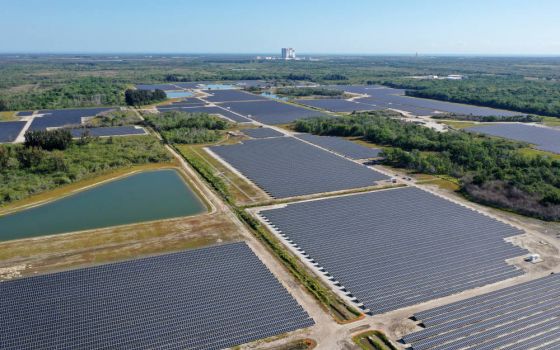A new area of unregulated gold mining in Peru's Madre de Dios region leaves a barren, cratered scar in the forest. (Photo/Barbara Fraser)
Editor's Note: EarthBeat Weekly is your weekly newsletter about faith and climate change. Below is the Nov. 20 edition. To receive EarthBeat Weekly in your inbox, sign up here.
Four women and an adolescent boy were killed, several more people were injured and more than 60 were left homeless by a landslide Wednesday at a gold mine in the Esmeraldas region on Ecuador's north coast. There are more than 50 small mines in the same area — some legal, many illegal, and all operating under conditions that are hazardous for the workers and their families.
Even the legal mines should not be operating now, because of court injunctions dating back a decade and because of the coronavirus pandemic, according to Fr. Enry Armijos, coordinator of Ecuador's National Ecological Ministry Network, which was launched three years ago by the Catholic Church, but which also includes other organizations.
Government officials know the mines are functioning, but turn a blind eye, Armijos told me the day after the landside. "No one says anything, except when a catastrophe like this happens," he said.
Meanwhile, backhoes gouge craters in the mature tropical forest in the remote region near the Colombian border. The dream of a fortune draws Ecuadorians and Colombians from far away, especially now that other jobs have vaporized with the pandemic. Miners and their families live near the craters in shacks made of plastic tarps.
Stripped of trees, the soil is unstable, and little or nothing is done to shore up the sides of pits like the one that collapsed on Wednesday. Heavy rains cause landslides and wash silt, often combined with the mercury and cyanide used to process the gold, into a nearby river.

Rescuers search for bodies after landslide trapped miners in Ecuador. (Photo/Courtesy of RENAPE)
The story is not uncommon. With international gold prices high, this kind of low-tech, high-risk mining has spread around the globe. The World Bank estimates that this style of mining employs at least 40 million people worldwide, in most of Africa, all of the Amazonian countries, Central America, Indonesia and other Asian nations.
Illegal mining is big business. According to a 2016 report by the Global Initiative Against Transnational Organized Crime, "about 28% of gold mined in Peru, 30% of gold mined in Bolivia, 77% of gold mined in Ecuador, 80% of gold mined in Colombia and 80-90% of Venezuelan gold is produced illegally."
Miners and some economists argue that this kind of mining provides more employment than large-scale commercial mines and drives local development. That's true to some extent — poverty rates have decreased dramatically in several regions of Peru where unregulated mining has been rampant for decades.
But the cost is high. Camps around unregulated mines tend to be lawless, violent places where women and girls are trafficked for sex and bandits ambush miners heading to town to sell their gold. The business, which some say is more lucrative than the illegal drug trade, is linked to organized crime and illegal groups, including the Revolutionary Armed Forces of Colombia, which launder money through the mining operations and use the gold to finance their activities.
The environmental damage from this kind of mining, where workers use backhoes to dig huge pits or blast away the soil with high-pressure hoses, is also extensive. Along with deforestation, mercury from gold processing accumulates in fish — and in the bodies of people who eat them. (That's also a legacy of the California gold rush, by the way.)
Of course, there would be no gold rush if no one bought gold. But despite consumer-awareness campaigns and increased official scrutiny, illegal gold is "laundered" through legal refineries in places like Switzerland and the U.S., making it appear to be legal. This award-winning multimedia report by journalists Paula Dupraz-Dobias and Dominique Soguel provides a striking close-up view of how the process works.
There are occasional bright spots in this dismal panorama. In Colombia, a few private investors bought some land in the late 1990s that had been stripped bare and cratered. They recontoured it, added nutrients and planted a combination of native and commercial timber species. When I visited two decades later, I saw a healthy secondary forest, where once-dead streams run again and at least one jaguar triggered a camera trap.
In Ecuador, in the wake of this week's tragedy, the ecological ministry network is calling for a halt to legal and illegal mining that is contaminating water sources, damaging ecosystems and affecting the health of local residents. It also urges greater oversight and enforcement of laws, as well as environmental remediation and reparations for harm to health.
Here's what's new on EarthBeat this week:
- Forty-two more Catholic organizations pledged to divest from fossil fuel investments or continue their non-investment policy, bringing to more than 200 the number of Catholic groups that have made such a commitment. Brian Roewe, NCR's environment correspondent, has the story.
- Roewe also reports on a Vatican-sponsored conference this week that has brought more than 2,000 young economists and entrepreneurs together virtually to reimagine the global economy as one that prioritizes not profit and growth, but justice, equity and caring for the poor and for our common home. Some of the U.S. participants describe their vision in a story by Cindy Wooden of Catholic News Service.
- Also at Catholic News Service, Jonathan Luxmoore writes that two major European Catholic commissions have warned that competition for the Arctic's resources is growing as the climate warms, threatening the region's biodiversity and its Indigenous people.
- Hurricane Iota multiplied the destruction in Central American countries still reeling from another powerful storm earlier this month, reports David Agren for Catholic News Service.
- And in Africa, which is already grappling with flooding, drought and locusts, sea level rise is causing coastal flooding and threatening to contaminate drinking water and irrigation systems with salt water. Hope Mafaranga has the story for Eos, a member of the Covering Climate Now consortium.
Here's some of what's new in other climate news this week:
- Thanksgiving, which should be a day of gratitude for what we have, is too often a day of excessive waste, writes Priya Krishna at The New York Times. She points to lessons from Indigenous, Black and brown communities for focusing instead on sustainable relationships with the earth and one another.
- A warming climate, pollution and invasive species are taking a toll on the iconic Great Lakes, with consequences for all species that depend on them, including humans. Tim Folger explains the web of ecological complexities for National Geographic.
- In Minnesota, most of the members of a panel that advises the state's Pollution Control Agency on environmental justice issues resigned when the agency approved a key permit for a controversial oil pipeline, reports Dan Kraker at MPRnews.
- Fish food made from seaweed may replace commercial food based on fishmeal, soy or corn, making aquaculture more productive and less environmentally destructive, reports Emma Bryce at Anthropocene.
- A new study suggests that unusually low temperatures and high rainfall between 1915 and 1920 may have contributed to the deadliness of the flu pandemic during those years — a finding that could have implications for the current novel coronavirus pandemic, writes Zoe Alexandra Klobus at Columbia University's GlacierHub blog.
Upcoming events:
The coming week will bring a much-changed Thanksgiving Day. Many people who usually gather with their extended families will limit themselves to a meal with those in their household, and some may find themselves alone. In the three decades I've lived outside of the U.S., some years I've celebrated with others, some years the day has passed without fanfare.
But it's always a good day for us to pause and reflect. Although we miss our families, there are things for which we can be thankful. To help us, Xavier University in Cincinnati, Ohio, offers a page of prayers for Thanksgiving — for gratitude, for healing and for an end to hunger.
Closing beat:
The day after Thanksgiving somehow became a frenzied shopping day in the U.S., but REI, the Seattle-based outdoor equipment cooperative, put a different spin on the day back in 2015 with its #OptOutside campaign. The folks at Creation Justice Ministries have picked up the idea, making it next week's suggestion in its list of weekly ways of caring for creation.
Amid the pandemic, going for a walk, jog or bike ride outdoors — with mask and distancing, as appropriate — seems like an especially good way to give thanks this year for and with creation.
What's the place where you feel most closely connected to the rest of creation? Snap a photo and tell us about it in 150 words or less, by submitting your Small Earth Story here.
If you like EarthBeat Weekly, why not share it with a friend? Feel free to forward this newsletter or pass along the link to EarthBeat Weekly on our website. And if someone forwarded it to you, you can sign up here to receive the newsletter in your inbox every Friday .
Thanks for reading EarthBeat!
Barbara Fraser
NCR climate editor
bfraser@ncronline.org
Advertisement






